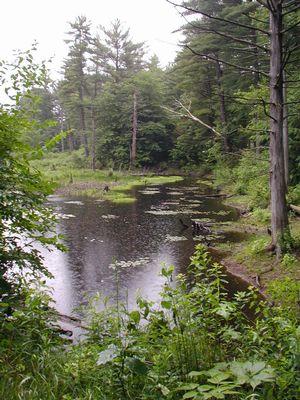What is a Wetland?

What Is A Wetland?
Wetlands are defined as those areas of the state that are inundated by surface or ground water with a frequency sufficient to support plants and animals that depend on saturated or seasonally saturated soil conditions for growth and reproduction. These areas are commonly known as ponds, bogs, fens, marshes, wet meadows, shrub swamps, and wooded swamps. In the Lancaster landscape, wetlands often occur in association with lakes, ponds, rivers, and streams. They may also, however, be isolated from any obvious connection to surface water. In all wetlands, the presence of water creates conditions that favor the growth of specially adapted plants (such as cattails, water lilies, alders, dogwood, red maple and swamp oak) and promote the development of wetland, or hydric, soils.
Why Protect Wetlands?
Wetlands serve a wide variety of functions and values beneficial to the health, safety, and welfare of the general public. It is estimated that less than 5% of Massachusetts is wetland and that nearly 50% of Massachusetts’s original wetland area has been lost or severely impaired due to draining, dredging, filling, or excavation activities associated with industrial and residential development and agriculture.
Some of the functions and values that wetlands provide include: flood control, water quality protection, wildlife habitat, recreation and economic benefits, and erosion control. While the degree to which a wetland serves these functions and values varies from wetland to wetland, each wetland works in combination with other wetlands as part of a complex, integrated system. These and other functions and values are described in more detail below.
Flood Control
During rain storms and snow melt events, the amount of water running over the surface of the land increases, and in severe storms, flooding may result. Many wetlands, particularly floodplain wetlands, have the capacity to temporarily store flood waters, during high runoff events. Although wetlands have often been referred to as natural sponges that soak up water, they actually function more like natural tubs, storing either flood waters that overflow riverbanks or surface water that collects in isolated depressions. As flood waters recede, the water is released slowly from the wetland soils. By holding back some of the flood waters and slowing the rate that water re-enters the stream channel, wetlands can reduce the severity of downstream flooding and erosion. In watersheds where wetlands have been lost, flood peaks may increase by as much as 80 percent. For example, on the Charles River in Massachusetts, the floodplain wetlands were deemed so effective for flood control by the U.S. Army Corps of Engineers that they purchased them rather than build expensive flood control structures to protect Boston.
Open Space and Aesthetics
Many wetlands are visually rich environments because of their ecological interest and diversity. Historically, writers, artists, and photographers have been drawn to wetlands trying to capture the beauty on canvas and paper. Open wetlands, such as marshes, are often considered to be more attractive than shrub or forested wetlands. Wetlands that provide high wildlife habitat are perceived as more aesthetically pleasing because people go to wetlands to see wildlife. In areas where most of the uplands have been developed, the remaining wetlands are increasingly valuable for open space. Wetlands along streams provide natural green belts and corridors for wildlife.
Hydrophtic Vegetation and Threatened and Endangered Species
Wetlands that have uncommon plant community types, such as bogs, fens, alpine peatlands, and black gum swamps, provide habitat for rare, threatened, or endangered species, or represent the best known local example of common plant community types, such as marshes, shrub swamps, and wooded swamps, make an important contribution to Massachusetts’ natural heritage and genetic diversity.
Summary
Wetlands are an important part of our national heritage. Our economic well-being and our quality of life have been largely dependent on our nation's wetlands since America was first settled. We must now take positive steps to protect wetlands to ensure that the values they provide will be preserved for future generations.

